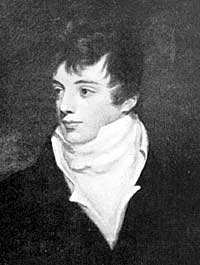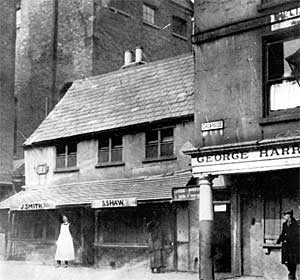Henry Kirke White.
By Mr. J. C. Warren.

Henry Kirke White by John Hopper, R.A.
AS the year to which these Transactions relate saw the centenary of the death of Henry Kirke White, it may not be out of place to put on record in these pages a few facts concerning him and his family which have not previously been published, or have hitherto been the subject of some uncertainty.
He was born on the 21st of March, 1785, and was the son of John White, a butcher in Nottingham, and his wife Mary, whose maiden name was Nevill. Their marriage took place at the parish Church of Greasley, on the 29th of July, 1777, a place and date which are now, we believe, for the first time recorded. They are described in the register as " both sojourners," from which fact it may not unreasonably be inferred that the marriage was a secret one, and that their residence in the parish was only sufficiently long to enable them to comply with the requirements of the law. The bride signs her name "Nevill." They appear to have been members of the Independent Congregation meeting in Castle Gate Chapel, Nottingham; and in the register of baptisms of that place of worship, which in 1837 was deposited with the Registrar-General in pursuance of the statute of William IV., is the entry:—"April 13th 1785, Henry Kirk (sic) son of John and Polly White." In the copy of this register, now in the hands of the chapel authorities, the entry is correctly transcribed. The baptisms of Henry's three sisters, and of his brothers, John Neville and James, are recorded in the same register.
The variance in spelling between the "Kirk" of the baptismal entry and the usually accepted name, "Kirke," raises a not uninteresting question as to which is correct. There seems little doubt that "Kirk" is the proper spelling. Not only does it so appear in the register of baptisms, but the poet writes his name in this way when he signs the articles of clerkship into which he entered on the 6th of July, 1801,1 with Messrs. George Coldham and Henry Enfield, then a well-known firm of attorneys in Nottingham, while in several places in the body of the articles, where the name was originally written "Kirke," the final "e" has been erased, shewing as distinctly as the signature that the form " Kirke " is wrong. Again, in the earlier spelling of the name of his cousin, Kirke Swann, the "e" is omitted, and we find in the Corporation Minutes, under date 29th September, 1808, an entry of the election of Kirke Swann to the office of First Chamberlain, and a memorandum of his taking the usual declaration of office, in both of which his name appears in the handwriting of Mr. Coldham, the then Town Clerk, who may be fairly relied on for accuracy in this particular, as "Kirk Swann."2
Some notes have recently come to the hands of the writer, which show how the poet and his cousin came both by the name Kirk, and by their relationship. From these notes it appears that Mary Nevill (Mrs. White) was the niece of a Mr. Samuel Kirk, Grocer, Long Row. Mr. Kirk had another niece, Mary Maddock,3 who, on the 29th February, 1780, married Edward Swann (Kirke Swann's father). In the Poll Book for 1774, the only contemporary record of Samuel Kirk so far forthcoming, the name is spelled without the " e."
The truth seems to be that the form " Kirke " was arbitrarily assumed by the poet, and we can easily understand that to a youth of his tastes it would appeal as having about it a certain greater flavour of antiquity and refinement than the more prosaic " Kirk," and when, after his death, he became famous, it is only natural that relatives bearing the name should continue the spelling, as Kirke Swann certainly did.
Henry Kirke White's articles of clerkship are still in the possession of Messrs. Enfield & Son, Low Pavement, who now represent the firm of Coldham & Enfield, and we are indebted to their courtesy for permission to inspect this and other documents, and to reproduce the poet's signature. Many specimens of his writing have been found among their business papers, and some of the drafts he copied are still preserved. Along with these is the draft of his apprenticeship indenture, which bears date the 21st of March, 1799. He would thus appear to have, in the first instance, entered into into an ordinary seven years' apprenticeship as a lawyer's clerk (a practice commonly observed until a comparatively recent period), though even then with the idea of eventually becoming an attorney, for the draft contains a clause to the effect that if, within two years from the date of the indenture, John White should pay to Messrs. Coldham & Enfield one half of the stamp duty then payable to the Inland Revenue on articles of clerkship to an attorney, the firm would enter into fresh articles with Kirke White to enable him to be admitted an attorney of the Court of King's Bench. It may here be mentioned in corroboration of what has been already stated as to the spelling of the poet's name, that in this draft he was originally called "Henry White" only, and "Kirk" (sic) was subsequently added, in the handwriting of Mr. Henry Enfield.

Kirke White's birthplace, Shambles, Nottingham.
Henry Kirke White was born in the house at the corner of the Shambles, at the western end of Cheapside, Nottingham, which was until lately known as the " Kirke White Tavern," and at an earlier date as the "Coach and Horses." In the time of John White (the father's) occupancy, and indeed for long before—as is also the case to this day—portions of the premises were used as butchers' shops. It has been claimed that the place of the poet's birth was in the Shoe Booths, now Exchange Row, and that the event occurred in the premises (of course since greatly altered and modernized) occupied by Mr. Samuel Smith, and looking towards Victoria Street. This contention, however, can scarcely be said to be supported by sufficient evidence, and if further proof of the correctness of the generally accepted view as to his birth-place be needed, it is given by the fact that the Cheapside house was acquired by John White in 1784, the year preceding his son's birth. The deeds relating to the property are now in possession of the Corporation, and through the kindness of the Town Clerk they have been examined. The title goes as far back as 1666, when by indenture of feoffment bearing date the 19th of June, " in the eighteenth year of our Sovereign Lord Charles II," the premises were conveyed to John Hydes of Nottingham, Haberdasher. In 1705 his only child, Ann Hydes, married Thomas Trigge,4 who was afterwards thrice Mayor of Nottingham, and the property eventually passed to two of their grandchildren, daughters and coheiresses of their son John Trigge.5 By indentures of lease and release of the 14th and 15th September, 1784, the premises were conveyed by these ladies to John White, the poet's father, who is therein described as "of the Town and County of the Town of Nottingham, Butcher." Edward Swann, referred to as a Grocer, joins in the release as a dower-trustee. The purchase money was £600, of which £300 was raised by mortgage. John White's signature is not that of a man of education, but, if allowance be made for the period and for his calling, it does not support the charge of illiteracy which has been made against him.
(1) This date is wrongly given as 1802 by Southey, and those who follow him, including the writer of the article on Henry Kirke White in the Dictionary of National Biography.
(2) In the entry of his baptism on the 24th July, 1784, in the Castle Gate Register, the name is also given as " Kirk."
(3) Probably a relative of Benjamin Maddock, afterwards a surgeon in Nottingham, the "dear Ben" to whom several of the poet's published letters are addressed.
(4) The family house of the Trigges was in the High Street, and stood on the site of the shop of Messrs. Armitage Brothers, Ltd., at the corner of that street and what is now Victoria Street.
(5) Another of their sons laboured under the name of Hydecius.
